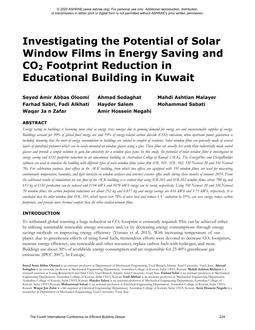Description
Energy saving in buildings is becoming more vital as energy crisis emerges due to growing demand for energy use and unsustainable supplies of energy. Buildings account for 30% of global final energy use and 39% of energy-related carbon dioxide (CO2) emissions, when upstream power generation is included, knowing that the most of energy consumption in buildings are related to comfort of residents. Solar window films are generally made of several layers of metalized polymers which can be easily mounted on window glasses using a glue. These films are usually less costly than industrially made coated glasses and provide a simple solution to gain low emissivity for a window glass pane. In this study, the potential of solar window films is investigated in energy saving and CO2 footprint reduction in an educational building in Australian College of Kuwait (ACK). The EnergyPlus and DesignBuilder software are used to simulate the building with different types of solar window films (solar film SOL 101, SOL 102, 3M Netural 20 and 3M Netural 70). For calibration purpose, four offices in the ACK building, from which two offices are equipped with 3M window films, are used for measuring continuously temperature, humidity, and light intensity on window surfaces and interior/exterior office walls during three months of summer 2019. From the calibrated results of simulations for one floor of the ACK building, it is evident that using SOL101 and SOL102 window films, about 700 kg and 653 kg of CO2 production can be reduced and 1154 kWh and 1078 kWh energy can be saved, respectively. Using 3M Netural 20 and 3M Netural 70 window films, the carbon footprint reductions are about 252 kg and 0.817 kg and energy savings are 416 kWh and 1.73 kWh, respectively. It is concluded that the solar window film SOL 101, which rejects over 78% of solar heat and reduces UV radiation by 95%, can save energy, reduce carbon footprints, and provide more thermal comfort than the other studied window films.
Citation: 4th Intl Conf: Efficient Bldg Design
Product Details
- Published:
- 2020
- Number of Pages:
- 8
- Units of Measure:
- Dual
- File Size:
- 1 file , 2 MB
- Product Code(s):
- D-ICEB20-27




